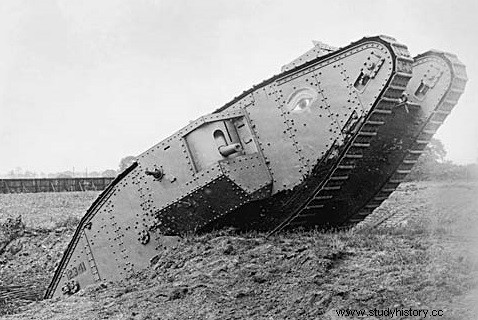 The Long Battle of the Somme was fought from July to November 1916 by the Allies against German forces in the Somme region of northern France. This very deadly episode was a turning point in the engagement of the British in the First World War, which engaged for the first time some 40 tanks on September 15 in Flers. This first major combined Franco-British offensive, under the command of General Foch and Douglas Haig, did not, however, lead (contrary to what the General Staff had hoped) for the advance of Allied troops on the Western Front. Due to bad weather, the exhaustion of the troops and the minimal territorial gain obtained, the offensive stopped on November 18, 1916 on the orders of Joffre.
The Long Battle of the Somme was fought from July to November 1916 by the Allies against German forces in the Somme region of northern France. This very deadly episode was a turning point in the engagement of the British in the First World War, which engaged for the first time some 40 tanks on September 15 in Flers. This first major combined Franco-British offensive, under the command of General Foch and Douglas Haig, did not, however, lead (contrary to what the General Staff had hoped) for the advance of Allied troops on the Western Front. Due to bad weather, the exhaustion of the troops and the minimal territorial gain obtained, the offensive stopped on November 18, 1916 on the orders of Joffre.
What was the purpose of the Battle of the Somme?
In 1915, the offensives led by the Allied armies stumbled, according to the high command, due to a lack of means. In connection with an increase in the production of cannons and shells, the generals imagined that victory would come from heavy artillery preparations, opening the way for the advance of the troops. It is in this spirit that the allies met on December 6, 7 and 8, 1915 in Chantilly, at the French General Headquarters commanded by General Joffre.
The idea of a simultaneous offensive, on several fronts, is shared by the French, the English, the Italians and the Russians:in the east, a general attack of the Russian army is planned; in Italy, an attack on the Isonzo; in the west, the French and the British would launch a vast offensive on the Somme, planned for the end of the spring or the beginning of the summer of 1916. At the same time, the Germans adopted, under the influence of Falkenhyan, the strategy of attrition , plan to “bleed white” the French army, by leading an assault on a nerve center:Verdun.
A plan modified by the outbreak of the Battle of Verdun
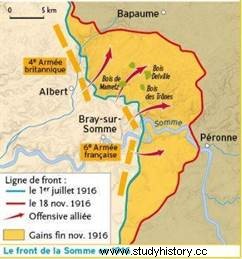 Planning was greatly disrupted by the outbreak of the Battle of Verdun on February 21, 1916. While the offensive on the Somme was initially conceived as a Franco-British battle in which the two allies were to participate equally, the French demanded as early as February, through the head of the French Military Mission to the British army, an increase British participation in the offensive. In addition, the front of attack was greatly reduced, dropping from 70 kilometers to 40 kilometers, the British part reaching 28 kilometers:the Battle of the Somme was to become a predominantly British offensive.
Planning was greatly disrupted by the outbreak of the Battle of Verdun on February 21, 1916. While the offensive on the Somme was initially conceived as a Franco-British battle in which the two allies were to participate equally, the French demanded as early as February, through the head of the French Military Mission to the British army, an increase British participation in the offensive. In addition, the front of attack was greatly reduced, dropping from 70 kilometers to 40 kilometers, the British part reaching 28 kilometers:the Battle of the Somme was to become a predominantly British offensive.
The operation would take place between the area of Albert – controlled by the Allies – and the surroundings of Péronne, controlled by the Germans. The objectives were nevertheless relatively vague:according to Jean-Jacques Becker, it was as much a question of wearing down the German army as of seeking the decisive battle which would make it possible to obtain the final victory.
A deadly offensive, for little progress
On July 1, 1916, after several days of intense artillery preparations, the French and British armies launched an assault on the German defences. If, in the southern part, the French Sixth experienced some success, the results were catastrophic for the British army:60,000 men (out of 120,000 men engaged) were put out of action on July 1, including 10,000 dead. Despite numerous preliminary bombardments, the attackers had come up against partially intact defenses and German machine gun fire.
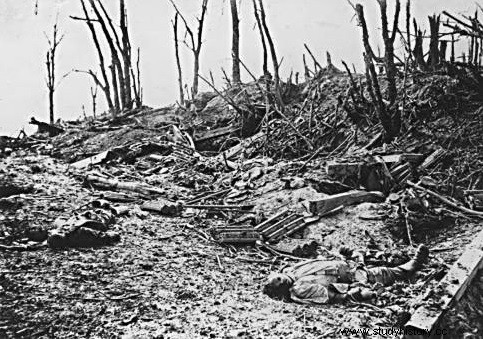 The battle, which stretched considerably over time, can be divided into three phases:the first offensives of the July 1 to 20; a long stagnation from July 20 to September 3; some progress from September 3 to November 18. In total, for an advance of only a few kilometers, the British lost 420,000 men, the French 200,000, including more than 100,000 dead. On the German side, the losses amounted to after 500,000 soldiers.
The battle, which stretched considerably over time, can be divided into three phases:the first offensives of the July 1 to 20; a long stagnation from July 20 to September 3; some progress from September 3 to November 18. In total, for an advance of only a few kilometers, the British lost 420,000 men, the French 200,000, including more than 100,000 dead. On the German side, the losses amounted to after 500,000 soldiers.
September 15, 1916, in Flers, the British used tanks (Mark IV) for the first time. Many of them fail to reach the line of attack, but the others make spectacular advances. Nevertheless, these tanks are still proving too slow, too unreliable, and too few in number to have any significant tactical effect.
As for the French or German tanks which appeared a few months later, its many faults — in particular its slowness (barely 6 km/h on the road) — give it a more psychological than real, most of the examples engaged in the fighting being destroyed or captured. It took several more months for tanks to become a truly decisive weapon.
At the end of 1916, the Somme offensive appeared to be a failure, as the enemy lines could not be broken. Germany still occupies the northeastern part of France, the balance of power still being favorable to the central powers. Worse, no decisive victory seemed possible on either side.
The Battle of the Somme, a turning point?
In many respects, the Battle of the Somme can be seen as a pivotal episode in the Great War. On the German side, Gerd Krumeich has shown in particular that if Verdun is not very present in the stories of the soldiers, the Battle of the Somme occupies a central place. In defensive positions in underground shelters, the German soldiers identified this battle as an episode in the defense of the homeland – albeit on French territory – against the British aggressor.
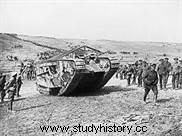 On the French side, the failure of the Somme may have caused some discouragement and fed, according to Pierre Renouvin, a weariness from the end of 1916, expressed with more vigor in 1917. For the British, the Somme marks the decline of an army of volunteers – who constituted the main troops sent and decimated on July 1, 1916 – in the advantage of an army of conscripts, whose training had begun at the beginning of 1916.
On the French side, the failure of the Somme may have caused some discouragement and fed, according to Pierre Renouvin, a weariness from the end of 1916, expressed with more vigor in 1917. For the British, the Somme marks the decline of an army of volunteers – who constituted the main troops sent and decimated on July 1, 1916 – in the advantage of an army of conscripts, whose training had begun at the beginning of 1916.
The Somme was also a highlight of Franco-British cooperation during the Great War. Indeed, the French and the British had to increasingly mobilize liaison officers in order to better articulate the relations between the two armies, the methods of liaison slowly tending to be implemented. Despite its failure and its human cost, the campaign in the Somme region served to demonstrate to Allied commanders that a significant improvement in cooperation and training was necessary to hope to defeat the German army. Indeed, despite terrible climatic conditions and serious tactical errors, this gigantic battle of material was for the Allies a learning period, especially in the use of artillery, which contributed to the final victory of 1918.
Memory of the Battle of the Somme
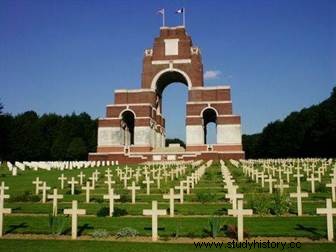 The Battle of the Somme left a lasting mark on British memory of the Great War. The bloodiest day in British history, the first day of the offensive gave rise to many accounts of the deadly nature of the battle. A lieutenant in a Scottish unit reaching the German lines with only two other men reportedly cried out, “My god, where are the rest of the boys? ". In a 1984 reissue of Martin Middlebrook's The First Day on the Somme – 1 July 1916, the author points out:"The only good that comes from this day is the excess of patriotism, courage and spirit of sacrifice shown by British soldiers”.
The Battle of the Somme left a lasting mark on British memory of the Great War. The bloodiest day in British history, the first day of the offensive gave rise to many accounts of the deadly nature of the battle. A lieutenant in a Scottish unit reaching the German lines with only two other men reportedly cried out, “My god, where are the rest of the boys? ". In a 1984 reissue of Martin Middlebrook's The First Day on the Somme – 1 July 1916, the author points out:"The only good that comes from this day is the excess of patriotism, courage and spirit of sacrifice shown by British soldiers”.
The Battle of the Somme was also quickly commemorated. At the initiative of the British government, the Thiepval (Somme) memorial was erected in 1928-1932, designed by the architect Edwin Lutyens. 45 meters high and taking the form of a triumphal arch, the monument includes the names of 73,367 British and South African soldiers killed on the battlefields of the Somme. Having become a veritable place of pilgrimage for the British – welcoming nearly 160,000 visitors each year – the monument adjoins a military cemetery that complies with British codes:the names are engraved on uniform stelae, regardless of rank or rank.
In addition, the development of an itinerary, the "remembrance circuit" of the Battle of the Somme, makes it possible to visualize the scars of the Great War on the landscapes, and visit the main monuments erected in memory of the battle:Ulster Tower (Irish memorial), ANZAC memorial (Australian and New Zealand), which recently hosted commemorations of the Battle of the Somme.
Bibliography
- The Battle of the Somme. The Forgotten Hecatomb, by Marjolaine Boutet and Philippe Nivet. Tallandier, 201 6.
- The Battle of the Somme, by Alain Denizot Poche. Tempus, 2006
